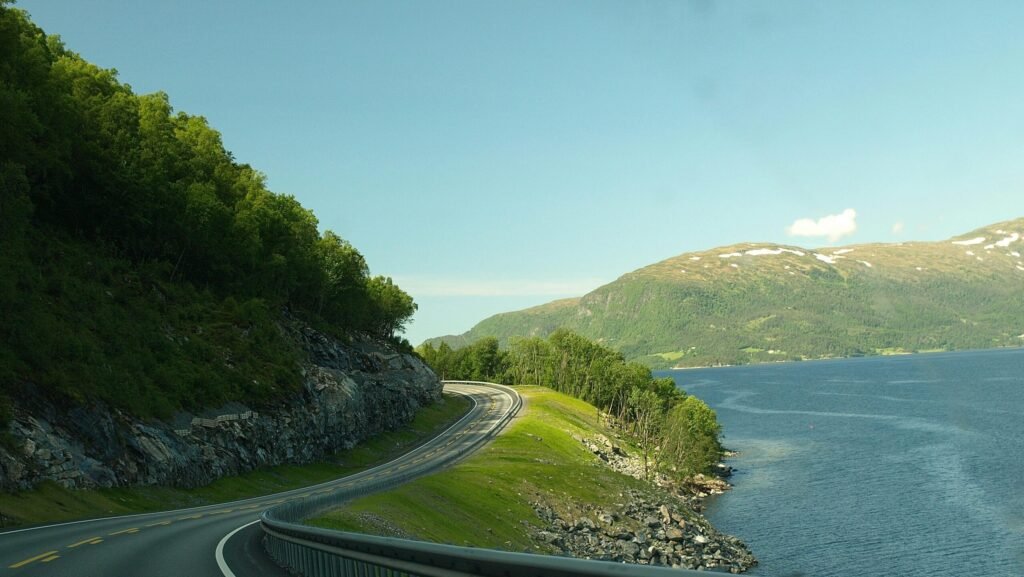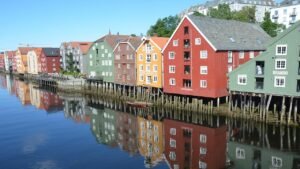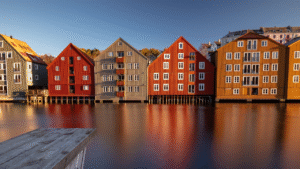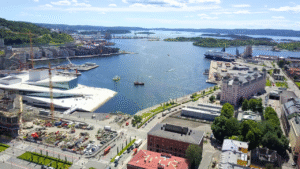Estimated reading time: 12 minutes
Key Takeaways
- A 7-day self-drive Norway travel itinerary offers the perfect introduction to this stunning Nordic country
- The route covers Oslo, coastal towns, famous fjords, and Bergen with carefully planned daily stops
- May through September provides the best weather conditions for this road trip itinerary
- Car rental gives you maximum flexibility to explore Norway’s scenic routes at your own pace
- Budget-conscious travelers can save money with strategic accommodation choices and meal planning
Table of Contents
- Introduction
- Why Norway? – Setting the Scene
- Itinerary Planning Essentials
- Detailed 7-Day Norway Itinerary
- Road Trip & Self-Drive Tips
- Additional Resources and Planning Tools
- Conclusion
- FAQs & Seasonal Tips
Introduction
From the surreal shimmer of the northern lights to epic fjord vistas and vibrant coastal cities, Norway promises adventure at every turn. Imagine winding roads that hug serene blue lakes, wooden villages with turf-roofed cabins dotting dramatic mountain valleys, and cultural treasures waiting in bustling urban centers. With majestic hikes like Trolltunga, UNESCO-protected towns like Bergen, and scenic drives along world-renowned routes, Norway is a wonderland for every traveler.
This blog is your complete guide to planning a 7-day Norway itinerary—ideal for beginners. Whether you love nature, crave cultural immersion, or seek the thrill of a road trip on Norway’s best scenic routes, this norway travel planner will help you craft an unforgettable week.
Want to see this for yourself? Click here to watch the video from this point.
Why Norway? – Setting the Scene
Norway’s diversity is unrivaled in northern Europe. It boasts deep blue fjords like Geirangerfjord and Nærøyfjord, historic coastal towns such as Bergen and Ålesund, vibrant cities including Oslo, and awe-inspiring mountain hikes like Preikestolen and Trolltunga [SOURCE].
A well-thought-out Norway travel plan for beginners ensures you maximize your experience. Many underestimate distances and the complexity of the terrain—planning a “best Norway road trip,” “Norway in a week,” or a “Norway scenic route itinerary” is essential for enjoying both famous and off-the-beaten-path sights in comfort and safety [SOURCE].
Self-drive itineraries and proper planning let travelers savor flexibility and adventure without missing Norway’s highlights or burning out with excessive transit [SOURCE]. The country has 18 National Scenic Routes that take you through some of the most stunning landscapes in Europe, making it a paradise for road trip enthusiasts.
If you’re looking to explore more of what Norway has to offer, check out our Best Norway Travel Destinations Guide for more inspiration.
Itinerary Planning Essentials
Why Use a Norway Travel Planner?
A reliable norway travel planner or itinerary tool saves time, helps avoid common pitfalls, and recommends routes tailored to your interests, from scenic drives to cultural stops [SOURCE]. Planning ahead is particularly important in Norway, where distances between attractions can be substantial and road conditions can vary seasonally.
Best Time to Travel
Late May to September offers long daylight hours, mild weather, and open mountain passes. Winter (October–April) is best for northern lights and winter sports, but many routes and attractions may be closed or limited [SOURCE]. For a 7-day self-drive itinerary, summer months provide the most reliable conditions for exploring Norway’s scenic routes. To help you plan your perfect Norwegian adventure, check out our comprehensive guide on the best time to visit Norway for detailed seasonal insights and travel tips.
Budget & Accommodation
Norway is pricey; save by booking accommodations (cabins, apartments, hostels), shopping at grocery stores, traveling off-peak, and using ferry/bridge passes wisely [SOURCE]. For more detailed budget planning and money-saving strategies, see our Norway travel budget guide. Consider a mix of hotels, fjordside cabins (“hytter”), Airbnbs, or campgrounds with scenic views [SOURCE].
Self-Drive Norway Itinerary Benefits
Renting a car or motorhome provides maximal flexibility—essential for reaching stunning but remote natural sites. Check road conditions and seasonal closures, as some iconic routes (like Lysevegen) only open May–October [SOURCE]. A self-drive itinerary allows you to stop wherever and whenever you want, perfect for photography enthusiasts and those who want to experience Norway at their own pace.
Detailed 7-Day Norway Itinerary (Day-by-Day Breakdown)
This suggested route mixes classic highlights with local favorites, designed for first-time visitors interested in Norway’s best road trip experiences.
Day 1: Oslo – Start in the Capital
Discover Oslo’s blend of modern architecture and Nordic history. Begin your exploration at the striking Oslo Opera House, where you can actually climb the roof for panoramic views of the Oslofjord. Next, immerse yourself in Viking history at the Viking Ship Museum, home to remarkably preserved vessels from the 9th century [SOURCE].
Spend time strolling along Karl Johans gate, Oslo’s main street lined with shops, restaurants, and leading to the Royal Palace. In the afternoon, head to Aker Brygge, a vibrant waterfront area perfect for dining and people-watching. For art lovers, the new Munch Museum showcases the works of Norway’s most famous painter, including “The Scream.”
Oslo is the ideal cultural gateway, easy to navigate and perfect for orienting yourself before the road trip adventure begins.
Top Picked Activities in Oslo
Day 2: Coastal Charm in Drøbak & Journey South
After breakfast in Oslo, collect your rental car and head south to Drøbak (about 40 minutes). This beautiful coastal town on the Oslofjord is famous for its white wooden houses, the Christmas House (open year-round), and charming main street filled with boutiques and galleries.
Take time to enjoy relaxed harbor views and lunch at one of the seafood cafes before continuing your journey southward. The coastal drive offers beautiful views and several small towns worth a quick stop. Plan to cover about 220 km today, arriving at your accommodation near Kristiansand by evening.
Day 3: Kristiansand & Southern Delights
Explore Kristiansand, celebrated for its sandy beaches, vibrant town square, Fiskebrygga (Fish Wharf), and Posebyen (historic district with white-painted houses). Start at the historic Kristiansand Cathedral before wandering through the old town’s well-preserved wooden buildings.
For families, Kristiansand Dyrepark (zoo/amusement park) makes for an exciting afternoon activity. Alternatively, beach lovers can enjoy Bystranda, the city beach just minutes from downtown. End your day sampling local delicacies like fresh shrimp or “sørlandschips” at a waterfront restaurant.
Top Picked Activities in Kristiansand
Day 4: Stavanger and the Iconic West
Drive to Stavanger (about 4 hours) via scenic routes dotted with lakes and fjords. Once there, wander the cobbled lanes of Gamle Stavanger (Old Stavanger), one of Europe’s best-preserved wooden towns with colorful 18th-century houses.
If you’re up for a moderate hike, Preikestolen (Pulpit Rock) offers breathtaking views over Lysefjord from its famous flat plateau. The hike takes 4-5 hours round trip and rewards you with one of Norway’s most photographed panoramas [SOURCE].
Stavanger marks the starting point of some of the best Norway road trip routes, notably the Lysevegen road (open May–October), making it a pivotal stop on your Norway in a week journey.
Top Picked Activities around Stavanger
Day 5: Odda & Trolltunga Adventure
Today features a morning drive north along the Hardanger Route (about 3 hours to Odda), passing waterfalls and fruit farms. If you’re an experienced hiker ready for a challenge, the iconic Trolltunga hike awaits—a strenuous, 10–12 hour trek ending at a dramatic rock ledge suspended 700 meters above Lake Ringedalsvatnet.
Start early (by 8 AM), pack plenty of water and food, and check weather conditions before attempting this hike [SOURCE]. For those preferring less demanding activities, explore nearby Hardangerfjord and the impressive twin cascade of Låtefoss waterfall instead.
For a closer look at the magic of Norway’s fjords, our Best Fjord Tours in Norway Guide provides excellent alternatives if the Trolltunga hike seems too challenging.
Top Picked Activities around Odda
Day 6: Bergen – Gateway to the Fjords
Drive to Bergen (about 3 hours from Odda), Norway’s second-largest city and a UNESCO World Heritage site. Begin at the historic Bryggen Wharf with its colorful wooden buildings dating back to the Hanseatic League era. The area is now filled with craft shops, museums, and restaurants [SOURCE].
Explore the vibrant fish market before taking the Fløibanen funicular up Mount Fløyen for panoramic views of the city and surrounding fjords. In the afternoon, visit the KODE art museums or St. Mary’s Church, the oldest building in Bergen.
For those wanting more fjord experiences, consider a short cruise to Nærøyfjord or Sognefjord—both easily accessible as day trips from Bergen [SOURCE].
Top Picked Activities around Bergen
Day 7: The Scenic Return and Final Explorations
On your final day, embark on a return journey to Oslo, choosing one of Norway’s National Scenic Routes. The Hardangervidda plateau route is particularly impressive, featuring the thundering Vøringsfossen waterfall and vast mountain landscapes [SOURCE].
The drive takes about 7-8 hours total, but plan for several stops to appreciate the views, take photos, and enjoy local food at roadside cafes. If time permits, make a detour to the charming village of Flåm or the Stegastein Viewpoint for one last spectacular Norwegian vista before returning to Oslo.
End your week-long adventure with a farewell dinner in Oslo, perhaps at Aker Brygge or the trendy Grünerløkka district, reflecting on the incredible landscapes and experiences of your Norway road trip.
Road Trip & Self-Drive Tips
Practical Advice for Your Self-Drive Norway Itinerary
Car rental: Book in advance, especially during summer months. Automatic transmission vehicles are less common and typically more expensive than manual ones. Consider a 4WD for mountain routes, though most main roads are accessible with standard cars.
Tolls & ferries: Norway uses an automated toll system on many routes. Most rental companies offer toll tags, but confirm the arrangement before departure. Car ferries are common when crossing fjords—check schedules and factor waiting times into your plans [SOURCE].
Fuel planning: Refuel when you see gas stations in larger towns; stations can be sparse in rural or mountain areas. Prices are high compared to other European countries, so budget accordingly.
Weather & road safety: Road and weather conditions change rapidly in Norway. Mountain routes can close suddenly in adverse weather, especially between October and May. Check the Norwegian Public Roads Administration website (vegvesen.no) for up-to-date information.
Scenic detours: The beauty of a norway scenic route itinerary is the opportunity for unexpected discoveries. Allow extra time for spontaneous stops—some of Norway’s most magical moments happen when you pull over at unmarked viewpoints or follow signs to small villages [SOURCE].
Packing essentials: Even in summer, bring waterproof gear, hiking shoes, and layered clothing. Temperatures can vary significantly between morning, afternoon, and evening, especially in mountain areas.
Additional Resources and Planning Tools
Itinerary planners & templates: Downloadable Norway travel itinerary templates are available from sites such as Visit Norway and regional tourism boards. These can help structure your daily plans while allowing flexibility for unexpected discoveries.
Maps & guides: The National Tourist Routes website provides detailed maps, seasonal information, and viewpoint recommendations that are invaluable for road trippers [SOURCE]. Consider downloading offline maps as mobile coverage can be spotty in remote areas.
Local insights: Travel blogs like The Hidden North and destination-specific resources offer up-to-date tips for road trippers, including “Norway travel plan for beginners” checklists [SOURCE].
For those interested in a deeper understanding of Norway’s landscapes and culture, our Scandinavia Travel Fjords Documentary provides stunning visuals and background information.
Mobile apps: Several apps can enhance your Norway road trip experience:
- YR – Norway’s official weather service app with highly accurate forecasts
- Ut.no – Detailed hiking trail maps and information
- AutoPASS – For managing toll road payments
- FjordNorway – Information about attractions in western Norway
Conclusion
A 7-day Norway travel itinerary offers the perfect balance: Oslo’s cultural energy, southern coastal charm, the wild west’s fjords and cliffs, and Bergen’s historic gateway—plus iconic hikes and some of Europe’s most scenic drives.
This carefully crafted route provides first-time visitors with an excellent introduction to Norway’s diverse landscapes and cultural treasures. From urban explorations to remote natural wonders, you’ll experience the essence of this Nordic paradise in just one week.
Adapt this route to your pace and passions—every traveler’s perfect Norway looks a bit different. Whether you prefer lingering in museums, challenging yourself with mountain hikes, or simply driving along fjord-side roads with frequent photo stops, this flexible framework accommodates various interests.
For more travel inspiration and to see these incredible Norwegian landscapes in stunning detail, be sure to visit Pathfinders Travel on YouTube, where you can watch Wonders of the World Travel Documentaries in 4K resolution.
FAQs & Seasonal Tips
Is driving in Norway difficult for beginners?
Roads are well-maintained, but narrow in mountainous and remote fjord areas. Norwegian drivers typically follow rules strictly, making for orderly traffic conditions. Take your time on hairpin turns and single-lane roads, and always observe speed limits and weather warnings [SOURCE].
What’s the best season for this itinerary?
Late May through early September offers safe driving conditions, open mountain roads, and lush scenery. Summer provides long daylight hours, with the “midnight sun” in northern regions. Winter (November to April) presents more challenging conditions but is magical if northern lights and snow are your aim [SOURCE]. For more detailed seasonal insights and planning tips, explore our comprehensive guide to the best time to visit Norway.
Are there good alternatives for non-hikers?
Absolutely! Norway offers many accessible natural attractions that don’t require strenuous hiking. Consider shorter walks to viewpoints, fjord cruises, scenic train journeys like the Flåm Railway, or cable cars that bring you to mountain vistas with minimal effort.
How can I modify the itinerary for winter?
Focus on coastal cities (Oslo, Bergen, Stavanger) and accessible fjord areas. Many high-altitude and remote routes close in winter. Switch out big hikes for winter sports or Northern Lights tours. Allow extra time for driving and be prepared for shorter daylight hours [SOURCE].
What are some off-the-beaten-path stops to consider?
Consider detours to Åndalsnes (for the famous Trollstigen road), the Atlantic Ocean Road with its dramatic bridges, or the less-crowded Gaularfjellet scenic route. The island of Karmøy offers beautiful beaches and Viking history, while the Ryfylke route provides stunning fjord views without the crowds of more famous areas [SOURCE].




